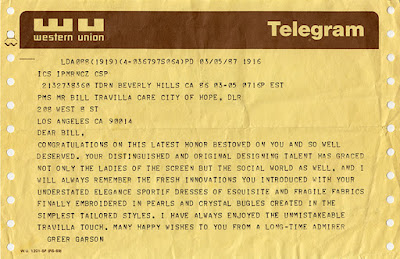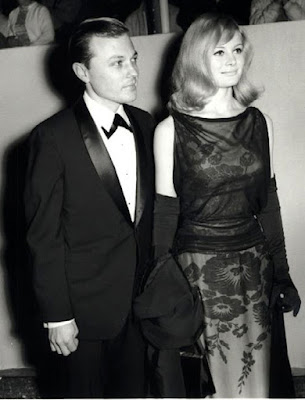Travilla won the Academy Award for Costume Design with his first nomination for The Adventures of Don Juan (1950). He was nominated again three times for How to Marry a Millionaire (1954), There's No Business Like Show Business (1955), and The Stripper (1964).
Though the Oscars had been televised since 1953, it took
decades before "Who are you wearing?" became the standard question on
the red carpet. Beginning in the 1960s, a few days before the big event,
fashion columnists would print what the female stars were planning to wear to
Hollywood's self-congratulatory night of nights. Among those I've managed to locate include:
1961
Usually, Mr. Blackwell and his Worst Dress List badmouthed the poor taste in clothes worn by movie queens at the recent Academy Awards. Still, this year, Travilla gave his opinion: "They think to be glamorous, they should wear gold lame or brassy sequins. When Greer Garson asked me to design a gown for her appearance on the show, I suggested a Grecian-draped white chiffon gown. She was the only one there who looked the time of year."
However, he forgot Shirley Knight, nominated for Best Supporting Actress in The Dark at the Top of the Stairs, also wore a Travilla creation. He was photographed holding a sketch (for another dress) while house model Gina Cord wore the finished garment of white silk faille decorated with large roses in varying shades of blue. Silk skirt panels in Capri blue and sapphire, draped over the strapless bodice, can form a stole.
However, it wasn't explicitly designed for Knight. Mrs. Robert E. Wade wore it first while photographed by the Los Angeles Times on the hood of a Chevrolet Corvair during the November 1960 Los Angeles car show.
1962
Debbie Reynolds presents Best Song in a long-sleeved,
criss-cross bolero bodice with crystal and chalk-white beads. The high
waistline leads into black chiffon layers, veiling an underskirt of white,
flared subtly near the floor.
Accompanied by her husband, Gene Persson, Shirley Knight wore a long gown of floral print ombre chiffon shaded in champagne, smoke, and black. It was boat-necked and sleeveless, with an overskirt of black chiffon and a slight train. MacDonald Carey and Shirley presented the Best Visual Effects. Like the year before, Travilla pulled from his retail collection.
1963
Lydia Bailey, lead and Dreamboat co-star, Anne Francis, wore a sleeveless silk damask formal with an ombre of dark to light stripes and an extended train.
1965
Originally scheduled to wear a white Balenciaga gown, Greer Garson chose instead to co-present Best Costume Design with Dick Van Dyk, wearing a black version of Marilyn Monroe's finale costume from No Business Like Show Business. The embroidered bodice had a slightly higher neckline and small bows at the shoulder, with a reported unbelievable five thousand individual discs of tulle draped from the hip to the hem. Garson added a blue-white diamond clip at the hip and carried white opera gloves. Regarding her wardrobe change, the fiery redhead told reporters, "Things like this give Miss Head a headache."
Actor Mike Connors escorted his sister Dottie in a shocking pink Travilla to the Governor's Ball at the Beverly Hilton Hotel.
1966
The first time, the show would be broadcast in color. While presenting the screenwriting award, Joanne Woodward chose a Travilla of apple green with white lace. Head was confident it would photograph all-white. Woodward's cryptic comment to reporters, "I hope that it makes Joan Crawford happy," dates back to 1958 when the actress was nominated for The Three Faces of Eve. Joanne proudly wore a homemade gown to the ceremony that cost $100 and took two weeks to create and won the award. Joan Crawford lamented to reporters that "Joanne Woodward is setting the cause of Hollywood glamor back twenty years by making her clothes." Crawford also lambasted Marilyn Monroe in 1953 for her attire, specifically a too-tight gown at the Photoplay Awards.
1968
Travilla was in attendance this year, photographed with Valley of the Dolls author Jacqueline Susann and Dolls leading lady Patty Duke. Duke wore a long, flowing, pleated white evening gown from the film.
Anne Baxter in a figure-hugging, bias-cut, scalloped, printed crepe gown in soft shades of yellow, blue, lavender, and green.
For her third ceremony, Greer Garson wore Travilla. This year, it was of yellow chiffon over a white A-line gown.
1970
Linda Harrison Zanuck, the four-month bride of Richard
Zanuck, wore a white crepe halter-necked, hyphen-pleated gown.
After the show, Travilla lambasted the ladies to the Los Angeles Times: "All of them belonged somewhere else, not at an event like the Academy Awards. The men came in tuxedos, but the women looked like they were getting ready for a cocktail party. The Oscars are a special occasion like the opera's opening night or a royal command performance for the queen. Candice Bergen looked like she would freak out, and Myrna Loy looked like a hostess for an at-home party. The stars should show some respect for the occasion. I was very disappointed that there were not more formals in the crowd."
1971
Women's Wear Daily reported the usually publicity-shy Jean Peters would attend the awards in a Travilla soft ecru wool suit with '40s flair. The jacket has broad, padded shoulders over a bias skirt.
1989
Dorothy Lamour wore a sequined gown in eggshell white with a
deep slit skirt hemmed in fox. Television audiences got a nice view when Lamour appeared in the "Cocoanut Grove" segment of
the twelve-minute opening created by producer Alan Carr.
























































